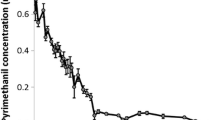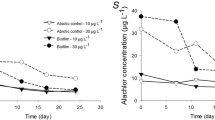Abstract
The effects of antifouling paint leachate containing tributyltin on community metabolism and nutrient dynamics were measured in situ on natural communities dominated by Fucus vesiculosus. The measurements were made in two areas with different salinities and at various TBT concentrations up to about 5 µg 1−1. A portable continuous flow-through system was used in which the communities were incubated for a week. Continual measurements of oxygen, temperature, light and flow rate of water were made. A Perturbation Index (PI) and an Absolute Disturbance Index (ADI) were used to describe the changes due to treatment relative to the control, and to obtain a total picture of disturbance using all measured parameters. Photosynthesis was particularly strongly affected and changes were obvious in oxygen production and nutrient uptake at TBT levels as low as 0.6 µg 1−1.
Similar content being viewed by others
References
André, C., N. Kautsky, U. Kautsky, C. Lindblad & M. Tedengren, 1989. In situ measurements of the functional response of benthic suspension feeders exposed to Cadmium and anti-fouling paint. Kieler Meeresforschung (in press).
Beaumont, A. R. & P. B. Newman, 1986. Low levels of tributyltin reduced growth of marine micro-algae. Mar. Pollut. Bull. Vol. 17, 10: 457–461.
Bryan, G. W., P. E. Gibbs, L. G. Hummerstone & G. R. Burt, 1986. The decline of the gastropod Nucella lapillus around south-west England; evidence for the effect of tributyltin from antifouling paints. J. Mar. Biol. Ass. U.K. 66: 611–640.
Cairns, J. Jr., 1983. Are single species toxicity tests alone adequate for estimating environmental hazards? Hydrobiologia 100: 47–57.
Cairns, J. Jr. & B. R. Niederlehner, 1987. Problems associated with selecting the most sensitive species for toxicity testing. Hydrobiologia 153: 87–94.
Carlberg, S., 1972. New Baltic Manual, International Council for the Exploration of the Sea Cooperative Research Report. Series A. Vol. 29: 1–145.
Giddings, J. & G. K. Eddlemon, 1978. Photosynthesis/respiration ratios in aquatic microcosms under arsenic stress. Wat. Air Soil Pollution 9: 207–212.
Giesy, J. P. Jr. & E. P. Odum, 1980. Microcosmology: introductory comments. In: J. P. Giesy Jr. (ed.), Microcosm in Ecological Research. Dept. of Engineering (DOE) Symposium Series: 52 conf-781101. Department of Energy. National Technical Information Service, Springfield, VA. pp. 1–13.
Hall, L. W. Jr., S. J. Bushong, W. S. Hall & W. E. Jonson, 1988. Acute and chronic effects of tributyltin on a Chesapeake Bay copepod. Envir. Toxicol. Chem. 7: 41–46.
Kautsky, H., 1988. Factors structuring phytobentic communities in the Baltic Sea. Ph. D. dissertation, University of Stockholm, pp. 1–29.
Kautsky, N., 1984. A battery operated, continuous-flow enclosure for metabolism studies in benthic communities. Mar. Biol. 81: 47–52.
Kautsky, N., H. Kautsky, U. Kautsky & M. Waern, 1986. Decreased depth penetration of Fucus vesiculosus (L) since the 1940's indicates eutrophication of the Baltic Sea. Mar. Ecol. Prog. Ser. 28: 1–8.
Kullenberg, G., 1981. Physical Oceanography. In: A. Voipio (ed.), The Baltic Sea. Elsevier Oceanography Ser. 30, Amsterdam, pp. 135–181.
Laughlin, R. B., R. Gustavson & P. Pendoley, 1988. Chronic embryo-larval toxicity of tributyltin (TBT) to the hard shell clam Mercenaria mercenaria. Mar. Ecol. Prog. Ser. 48: 29–36.
Laughlin, R., K. Nordlund & O. Linden, 1984. Long-term effects of tributyltin compounds on the Baltic amphipod, Gammarus oceanicus. Mar. Envir. Res. 12: 243–271.
Lindblad, C., N. Kautsky & U. Kautsky, 1986. An in situ method for bioassay studies on functional response of littoral communities to pollutants. Ophelia Suppl. 4: 159–165.
Lindblad, C., U. Kautsky & N. Kautsky, 1988. An in situ system for evaluating effects of toxicants to the metabolism of littoral communities. In J. Cairns Jr. & J. R. Pratt (eds.), Functional Testing of Aquatic Biota for Estimating Hazards of Chemicals, ASTM STP 988. American Society for Testing and Materials, Philadelphia, pp. 97–105.
Lindvall, B., 1984. The condition of a Fucus vesiculosus community in a polluted archipelago area on the east coast of Sweden. Ophelia Suppl. 3: 147–150.
Rönnberg, O., J. Lehto & I. Haahtela, 1985. Recent changes in the occurrence of Fucus vesiculosus in the Archipelago Sea, SW Finland. Ann. Bot. Fenn. 22: 231–244.
Schonbeck, W. M. & T. A. Norton, 1980. The effects on intertidal fucoid algae of exposure to air under various conditions. Botanica Marina 23: 141–147.
Strømgren, T. & T. Bongard, 1987. The effects of tributyltin oxide on growth of Mytilus edulis. Mar. Pollut. Bull. 18: 30–31.
Tedengren, M., M. Arnér & N. Kautsky, 1988. Ecophysiology and stress response of marine and brackish water Gammarus species (Crustacea, Amphipoda) to changes in salinity and exposure to cadmium and diesel oil. Mar. Ecol. Prog. Ser. 47: 107–116.
Underwood, A. J. & C. H. Peterson, 1988. Towards an ecological framework for investigating pollution. Mar. Ecol. Prog. Ser. 46: 227–234.
Valkirs, A. O., B. M. Davidson & P. F. Seligman, 1987. Sublethal growth effects and mortality to marine bivalves from long-term exposure to tributyltin. Chemosphere 16(1): 201–220.
Wong, P. T. S., Y. K. Chau, O. Kramar & G. A. Bengert, 1982. Structure-toxicity relationship of tin compounds on algae. Can. J. Fish. Aquat. Sci. 39: 483–488.
Author information
Authors and Affiliations
Rights and permissions
About this article
Cite this article
Lindblad, C., Kautsky, U., André, C. et al. Functional response of Fucus vesiculosus communities to tributyltin measured in an in situ continuous flow-through system. Hydrobiologia 188, 277–283 (1989). https://doi.org/10.1007/BF00027793
Issue Date:
DOI: https://doi.org/10.1007/BF00027793




